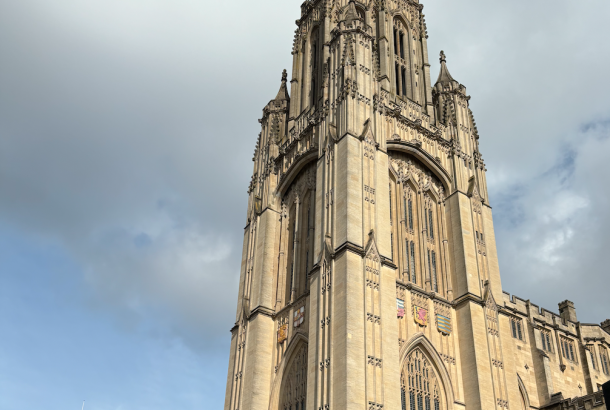Interview: Professor Phil Manning
It’s 11 o’clock on a Friday morning and I’m due to meet Professor Phil Manning any minute. He’s one of the most eminent palaeontologists in the country, so what could be a more appropriate place to meet than the foyer of the Manchester Museum, where the skeleton of a 7.5m long Gorgosaurus has just moved in?
As I stare in awe at this magnificent beast, Prof Manning walks round the corner and instantly begins to tell me all about it.
“It’s one of the most complete tyrannosaurs known to science because it’s pretty much 90 per cent complete, which is remarkable,” he explains. “It’s the ancestor of the T-Rex—everyone always wants to know about the Coca Cola of the dinosaurs, which is the T-Rex, but really, to unpick its family tree is as exciting a story.”
It is indeed an astonishingly complete skeleton. I learn that it was the centrepiece of this year’s Summer Exhibition at the Royal Society, an event that Prof Manning is very familiar with, having exhibited at it twice in the last three years.
GROWING UP
We move upstairs to the quieter surroundings of the top floor. I start by asking him a rather obvious question, about what sparked his interested in palaeontology as a kid.
“Every single child goes through a phase of being fascinated by either archaeology or dinosaurs,” he replies. “Most kids grow out of it—I didn’t! I’ve been fortunate enough just to pursue that for the rest of my life. One of my friends puts it very eloquently. He says “It’s the Peter Pan subject.’ We don’t actually ever grow up.”
I was the same. I’m sure that my countless dinosaur sticker books are still lurking around the house somewhere. A huge chunk of my childhood dinosaur knowledge has vanished, so I joke that this interview ideally should have taken place 15 years ago. Prof Manning knows all too well how about the inquisitive nature of children. “People ask me what the most frightening thing about doing public lectures is,” he says. “I tell them that it’s the three-foot high experts who come to your talks!”
Professor Manning digs in various excavation sites across the world, particularly in the Hell Creek formation in the United States. He often brings undergraduates with him to assist. Whilst on this topic, I ask him if he can recall his first dig.
He smiles fondly as he reminisces. “My first dig was rendering my father’s garden to rubble!” He tells me that whilst exploring the garden of his Somerset home, he saw a bone sticking out of the wall of a shed. “I remember seeing a funny shape and thinking, ‘That’s a fossil.’ I’d already been reading books on them.” Grabbing a nearby hammer, he tore down the shed and picked up the fossil, which turned out to be a vertebra from a Plesiosaur.
“I got absolutely fried by my father for basically dismantling a shed at the bottom of the garden without telling him!” he laughs. “But I got my first fossil, my first vertebra of a sea dragon from the Jurassic era. At that point, I was lost. This was where I wanted to be and what I wanted to do.”
FAVOURITE DINOSAUR
I’m sitting face-to-face with a world-renowned palaeontologist and regardless of how important and interesting his research may be, there’s one question which I’m desperate to ask him.
“What’s your favourite dinosaur?”
Not the most intellectually-stimulating question I’ll ever ask. Unsurprisingly, he’s initially reluctant to pick just one. “It’s like having a big family and being asked to choose your favourite child!” he jokes. However, he proceeds to tell me about a particularly memorable image from one of the illustrated dinosaur books he owned as a child. “There was a picture of a single fossil, and it was of an Archaeopteryx, which some people often call the missing link between dinosaurs and birds,” he reminisces. “Some would argue that it’s the first bird and I’m prone to agree. But of course it has many dinosaurian characteristics and was around at the time of the dinosaurs.
“Its ancestors were predatory dinosaurs, so technically all birds are dinosaurs. So by de facto I argue that Archaeopteryx is both my favourite bird and dinosaur. I’ve recently had the pleasure and honour of working on one of these incredibly rare fossils.”
Caught up in the moment, I begin to talk about my favourite prehistoric beasts. I tell Professor Manning of my admiration for the Triceratops and he is quick to agree. “It’s a remarkable creature, it’s akin to a reptilian rhinoceros,” he says. “Of all the ceratopsian dinosaurs, it’s the only one with a solid frill, that shield that goes at the back of its head and it’s the only one that’s made of solid bone.
“I do have a soft spot for Triceratops. I dug up the brain case of one this summer!”
I recall the countless dinosaur sticker books I had as a child. Listed below each image were multiple facts about the relevant dinosaur, including which part of the modern world they would have originated from. An abiding memory of mine is that only one would have come from modern-day England—Megalosaurus.
“Dinosaurs are a British invention, we must never forget that,” Prof Manning emphasises. “It was Sir Richard Owen who, back in 1841, came up with the idea of a distinct saurian tribe, which united these bones that people had been discovering throughout the previous 10–20 years. He didn’t come up with the name until the following year, so in 1842, dinosaurs were effectively born into the scientific language.”
I learn that Megalosaurus was first described properly in 1824. “For me, it’s the first dinosaur which was still technically not a dinosaur because dinosaurs had not yet been invented,” he explains. “But it has a much more interesting history.”
He tells me that the lower part of a Megalosaurus femur was found in the 17th Century. Of course, no one had the slightest clue what it was. Robert Plot, a renowned English naturalist, chose to name it after the object that it most closely resembled, leading to the rather unfortunate name of ‘Scrotum Humanum.’
“I’m quite grateful that particular name has fallen into disuse!” laughs Prof Manning. “Can you imagine kids going into a museum and saying ‘Mum, Dad, look at the size of that—‘ well, let’s not go there!”
CURRENT PROJECTS
Professor Manning chuckles when I ask him what projects he is currently working on. The list is so long it could probably fill this whole page. “A phrase that my splendid colleague Roy Wogelius uses is that we are ‘constipated with data.’ And we are! We have a vast data set because we are working on so many different research fronts.
“If you ask me what I’m researching at the moment, it’s everything from Egyptian mummies to the earliest life on Earth some 3.8 billion years ago, and just filling in the gaps in between. We have an international research programme which involves working on samples from literally every continent on Earth. It’s breathtakingly fun to be involved with such a diverse research programme.”
What happens next is undoubtedly the most heart-warming part of the whole interview. “I think I’ve had two vacations in ten years, because my research, my work, my life is my vacation—I love what I do. As a result, you don’t really need holidays if what you’re doing is what you want to be doing. I don’t need to take a break—if I do take a break I’m actually missing my work, which is a bizarre way of thinking of it!”
I also learn that he is currently in the process of naming two dinosaurs, although he’s not overjoyed at the prospect. “I’ve got a couple on the backburner, although I’d much rather be working out how the animals function. Give me a toy—yes, it’s easy to name a toy. But pull that toy apart and see how it works – now you’re talking!”
If you’re reading this Phil, and you’re still struggling for motivation, I reckon Andysaurus would be perfect.
DINOSAURS IN THE MEDIA
I move onto a new topic, the portrayal of dinosaurs within the world of television, film and radio. As a physicist, I have a tendency to point out obvious scientific flaws in films—the huge boom that accompanies the explosion of the Death Star still makes me shudder. Since we have no real understanding of how dinosaurs actually behaved—only what they looked like—there is a lot of speculation involved when it comes to portraying them in films. I ask Prof. Manning if he occasionally despairs at these wild guesses and often ludicrous errors. My question is met with a firm shake of the head. “Never. I never despair, because dinosaurs are a gateway into science for kids.
“Dinosaurs have been part of popular literature and in the media ever since their invention.” He goes on to quote the opening paragraph of Bleak House, in which Charles Dickens makes reference to none other than a Megalosaurus. He tells me about the famous Great Exhibition of 1851, in which the grounds surrounding the Crystal Palace were filled with sculptures of all kinds of dinosaurs. Moving on into the 20th Century, he talks about Sir Arthur Conan Doyle’s The Lost World and the iconic animation Gertie the Dinosaur.
The key point Prof. Manning makes throughout is that no matter how ridiculously dinosaurs may be portrayed, it doesn’t matter, as long as they’re still inspiring the next generation. “People have always been fascinated by them and I think that when people see them in the media, it doesn’t matter if it’s Walking with Dinosaurs, even Talking with bloody Dinosaurs, so be it!
“If kids get excited by them and take that next step to picking up a book, or even nowadays googling dinosaurs and finding information about them online, little do they know that they’re taking the first few steps towards becoming a scientist.”
GENERAL THOUGHTS ON SCIENCE
Palaeontology, just like my chosen discipline of astrophysics, is an immensely popular area of science for people of all ages. I ask Prof Manning why he thinks this is. Obviously, he is delighted that his field interests so many people, but he is quick to voice his concern about the “Science is so beautifully linked together, but it’s compartmentalised by people who don’t understand it,” he says. “Areas of more applied science, such as nuclear physics and medicine, are often sold to us by the media as being ‘core science.’ That worries me hugely, because there is no such thing as core science—all science is core.”
Prof Manning goes on to explain about his work with other departments. He was fundamental in helping to establish the Interdisciplinary Centre for Ancient Life (ICAL), which fosters collaboration between staff members from multiple schools within the university. He acts as the director of the new centre.
Professor Manning is perhaps the truest definition of a scientist, someone whose passion and enthusiasm for his field is unmatched by anyone I’ve ever spoken to. He is incredibly appreciative of the work taking place in other departments and his desire to collaborate with researchers from every branch of science shows how forward-thinking he really is. He has impeccable knowledge of so many different disciplines—at one point in the interview we spoke for a good ten minutes about astrophysics, in particular the Rosetta mission.
ADVICE
I conclude the interview by asking Prof Manning if he has any advice for people hoping to follow him into palaeontology, or indeed any area of science. His message is clear: “If you really love doing one particular thing at school, and you can get a qualification in it, do it. Pursue it.
“Often schools will give you advice to do things which you really don’t want to do, but it’s the best thing for you to do, but it’s thinking with your head. Sometimes, with science, the best place to start the thought process is with your heart.
“If you are truly passionate about something and you truly love working in a particular area, that’s the area in which you will probably make the most impact. Enthusiasm and passion are things that cannot be taught and they are things that we always seek in our best students. Because they’re the ones who tend to excel.”
After completing my GCSEs, I was unsure about what direction I wanted my life to go in. I considered all sorts of careers, although at that time I had dollar signs flashing in my eyes and only really cared about which job would make me the most money. It was only when it came to applying to university that I realised that the world of astrophysics was where I belonged. I express my relief at realising this before it was too late to Professor Manning.
“You have one chance at life,” he replies. “To do something for your whole life that you don’t truly enjoy, I would find it soul-destroying. I think it’s very good if you can pursue something you thoroughly enjoy in life. That’s so important.”
To learn more about ICAL, visit www.ical.manchester.ac.uk/
You can follow Professor Manning on Twitter: @DrPhilManning







